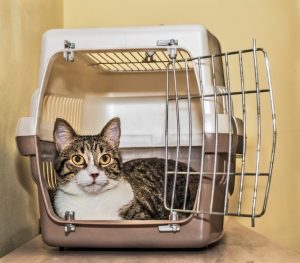Taking your cat to the vet can be a daunting task can be exhausting for you and possibly down-right frightening for your cat. Cats generally don’t like to do anything that is outside their daily routine, and a trip to the vet is not within  their daily routines. Let’s find a way to make trips to the veterinarian’s office as smooth as possible for both you and your little feline friend.
their daily routines. Let’s find a way to make trips to the veterinarian’s office as smooth as possible for both you and your little feline friend.
Decline In Cat Visits to Vet
Dr. Heather Loenser, emergency veterinarian at Crown Veterinary Specialists in Lebanon, NJ, points out that the number of cat visits to the vet has declined by over 13% over the past five years (2012 American Veterinary Medical Association Pet Ownership and Demographics Source book), and veterinarians are worried that important preventable diseases are being missed. Diseases like arthritis, kidney disease, diabetes and obesity can be difficult for owners to detect on their own and without proper management, cats can suffer silently. Sixty nine percent of cat owners believe their cat is at the right weight, but veterinarians disagree as they have noted an increase of over 90% of cats with excess body weight in the past five years (2012 Banfield State of Pet Health). Half as many cats receive exams as dogs (Bayer Veterinary Care Usage Study III: Feline Findings), leaving many veterinarian’s favorite pet, out in the cold in regards to proper veterinary care.
What You Will Need:
- Favorite Toys
- Treats
- Two Blankets
- Cat Carrier
- List of Questions for the Veterinarian
5 Veterinarian Trip Problems & Solutions
Problem #1: Many cat owners don’t recognize the need for cats to see a vet yearly.
Solution: Cats must see their veterinarian once a year for a well check. Cats can have something wrong and you may not know it, but a vet will be able to spot the problem and help. Plus, you can ask the vet all of your questions about feeding, toys, litter, grooming, anything that you might want to know. Visiting the vet yearly is vital for your cat’s health and more affordable than you think. Make an appointment today!
Problem #2: Cats often fear of going in a carrier.
Solution: Minimize your cat’s anxieties about going into the carrier with treats, catnip and her favorite toys. Set the carrier out way before the appointment. Leave the door open and add some treats and a couple of her favorite toys. There’s no need to push her to get into it. She’ll get curious and check it out on her own, probably while you’re sleeping. If it’s a hard plastic cat carrier add a cozy blanket, and you might find her napping in it. When it’s time to go to the vet’s your cat shouldn’t be anxious.
Problem #3: Cats can fear the car ride to the vet’s office.
Solution: Make the car ride as comfortable as possible for your cat. Once you (gently) get the carrier to the car carefully place it on the seat in a way that your cat can see you. Strap the seatbelt over the carrier so the bumps on the road don’t have it jumping around. Bring treats and toys along and praise her along the way. Talk to her while you are driving in a nice, upbeat voice. If she senses that you are nervous then she will get nervous. Stay calm. Keep the radio off as your cat probably won’t like the extra noise. Dr. Cortney Katsur recommends you “take short car rides more frequently to get your cat used to car and not negatively associate it only with a trip to the vet”.
Problem #4: The waiting room can be a scary place for cats.
Solution: The waiting room at the veterinarian’s office might have other pets in it – dogs, cats, and possibly other animals. This can scare your cat. If your cat gets scared you can help her with a blanket. Since cats tend to feel more comfortable and calm in tight spaces you can keep her in the carrier with the blanket over it while in the waiting room. If you can open the door a little to pet and reassure her do so, but if it looks like she’ll bolt keep it closed for now.
Problem #5: Anxiety during the appointment.
Solution: It’s completely natural for your cat to be anxious during the appointment. There may be an assistant that comes in before the vet who is a stranger to your cat, and this assistant will need to hold and check your cat. That might freak her out a little bit, and you might want to step in to help. Stay back unless the assistant asks for help and pet your cat when the assistant is writing something down. You can feed her treats during this process too. If she’s never met the veterinarian before that will be anxiety producing as well. Same rules here. Pet your cat and speak calm to her during the examination. Praise her with kind words and treats when possible. Remember to stay calm yourself, because your cat will sense how you feel.
The next time you need to visit the vet’s office your cat won’t be so nervous. Plus, she’ll be more familiar with the waiting room, the examination room, the assistants, and the veterinarian. You can even ask to bring her in to get her weighed or have her claws clipped just so she can get used to going to the vet’s office. Use these techniques to create a smooth trip to the veterinarian for even the most nervous of cats.
Photo: Thinkstock









